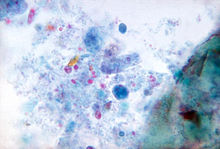Dientamoeba fragilis
| Dientamoeba fragilis | |
|---|---|

| |
| Scientific classification | |
| Domain: | Eukaryota |
| (unranked): | |
| Phylum: | |
| Class: | |
| Order: | Trichomonadida |
| Family: | |
| Genus: | Dientamoeba
|
| Species: | D. fragilis
|
| Binomial name | |
| Dientamoeba fragilis Jeeps et Dobell, 1918
| |
Dientamoeba fragilis is a species of single-celled excavates found in the gastrointestinal tract of some humans, pigs and gorillas. It causes gastrointestinal upset in some people, but not in others.[1] It is an important cause of traveller's diarrhoea, chronic diarrhoea, fatigue and, in children, failure to thrive. Despite this, its role as a "commensal, pathobiont, or pathogen" is still debated.[2] D. fragilis is one of the smaller parasites that are able to live in the human intestine. Dientamoeba fragilis cells are able to survive and move in fresh feces but are sensitive to aerobic environments. They dissociate when in contact or placed in saline, tap water or distilled water.[3]
Etymology
- Di refers to the two nuclei in the trophozoites (feeding stage of the organism).
- Ent refers to the enteric environment in which the organism is found.
- The species name fragilis refers to the fact that the trophozoite stages are fragile; they do not survive long in the stool after leaving the body of the human host.
It was first described in 1918.[4]
Dientamoebiasis
There is continuous debate on whether D. fragilis should be considered to be a harmless organism or a pathogenic parasite.
Diagnosis
In order to diagnose the parasite, patients are required to provide (multiple) fresh stool samples that have been preserved for parasite examination. The multiple samples are required because of parasite detection being difficult, therefore, a sample might be obtained each day to help increase the sensitivity.[5] Patients can also be tested for E. vermicularis since the two parasites are known to coincide.[7]
Treatment
Once diagnosed, E. vermicularis is also searched for throughout the body. The age and clinical status of the patient will determine the treatment given. If the patient is a child, a temporary treatment would be offered to test if symptoms can be alleviated, otherwise, another diagnosis and treatment are required. If the child is asymptomatic, then treatment is not necessary.
Epidemiology
Dientamoeba fragilis has an estimated prevalence throughout the United States. Unlike majority of parasitic infections, D. fragilis is more prevalent in well-developed countries as opposed to disadvantaged and resource poor nations.[9] The parasite is also endemic in crowded communities (i.e institutions), populations with unsatisfactory sanitation conditions, and individuals who travel to underprivileged countries.[3] Globally, the prevalence of D. fragilis ranges from 0.3% to 90%, occurring in multiple countries including many urbanized cities such as Los Angeles, California and Sydney, Australia. Recently, D. fragilis was considered to be more prevalent than Giardia, thus leading to better diagnostics.[9]
Phylogenetics
Dientamoeba fragilis is a type of
The
When inside the host, the parasite infects the mucosal crypts of the large intestine. They primarily affect the cecum and proximal colon. It is assumed that when D. fragilis is inside the colon, it reproduces asexually by binary fission. From there, the trophozoites are in the lumen of the colon, and are excreted as wastes.[12] D. fragilis is not considered to be invasive nor cause cell or tissue damage.[3]
Build
D. fragilis replicates by binary fission, moves by pseudopodia, and feeds by phagocytosis. The cytoplasm typically contains numerous food vacuoles that contain ingested debris, including bacteria. Waste materials are eliminated from the cell through digestive vacuoles by exocytosis. D. fragilis possesses some flagellate characteristics. In the binucleated form is a spindle structure located between the nuclei, which stems from certain polar configurations adjacent to a nucleus; these configurations appear to be homologous to hypermastigotes’ atractophores. A complex Golgi apparatus is seen; the nuclear structure of D. fragilis is more similar to that of flagellated trichomonads than to that of Entamoeba. Also notable is the presence of hydrogenosomes, which are also a characteristic of other trichomonads.[13]
See also
- List of parasites (human)
References
- PMID 15891119.
- PMID 27716507.
- ^ a b c d Dientamoeba Fragilis Infection at eMedicine
- PMID 15258093.
- ^ PMID 20401204.
- PMID 15956388.
- ^ "Dientamoeba fragilis FAQs". CDC. 17 September 2020.
- ^ a b "Parasites - Dientamoeba fragilis - Treatment". CDC. Retrieved December 9, 2016.
- ^ ISBN 9789535122241.
- PMID 16940260.
- PMID 23872523.
- ^ "Dientamoeba fragilis: Biology". Parasites. Center for Disease Control. Retrieved December 10, 2016.
- ISBN 978-3-642-09542-9.
